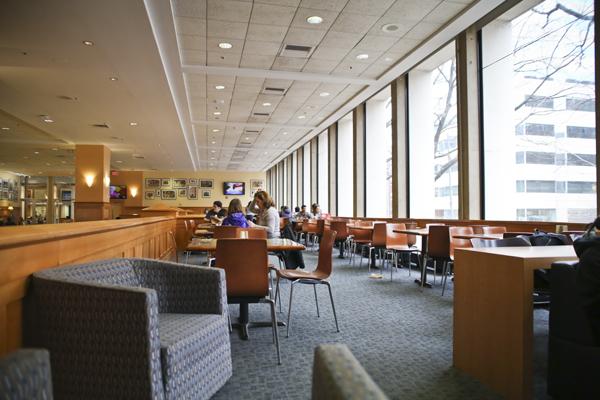The University is asking students to rate their on-campus dining experience — a move that comes as GW’s contract with dining provider Sodexo ends next year.
A randomly selected group of undergraduate students received an email survey from Director of Campus Dining Nancy Haaga last week, with questions about how much money they spend at on-campus and off-campus dining venues, and their dining habits on weekdays and weekends.
Other questions asked students about potential dining changes — like the idea of an “all-you-care-to-eat” meal plan and the opportunity to use technology to order food.
The University has partnered with dining company Sodexo since 2006, and that contract is set to expire at the end of next year. That’s left students with questions about how meal plans and dining venues could change with a potentially new service provider coming to campus.
The nearing expiration date came into focus during this spring’s Student Association campaigns. Casey Syron, who was elected executive vice president last week, campaigned on creating a swipe system, rather than having student pay by the weight of their food.
SA President-elect Andie Dowd said during the presidential debate last week that she will advocate for student dining to stay in the Marvin Center when the contract ends next year and new dining venues open at District House. University officials have not said that they are considering eliminating any student space on the first floor of the Marvin Center.
Freshmen are required to spend $700 per semester at on-campus dining facilities such as J Street on the Foggy Bottom Campus or Pelham Commons on the Mount Vernon Campus. The per-pound or choice-based system tends to differ from traditional college dining halls, where students have a certain number of meal swipes per day or per year.
Haaga and Bernadette Thomas, J Street’s general manager, declined to comment through a GW spokesman about whether the survey was aimed at determining what the University could look for in a new service provider.
“We regularly send the GW community surveys about their campus dining experiences so that we may continue to review and adjust our offerings and practices to align with student, faculty and staff preferences,” University spokesman Kurtis Hiatt said.
Junior Molly Hogan, who is the chair of the student dining board, said she expects that GW sent a survey now to get student feedback before making any changes to campus dining over the summer.
“If you’re getting information from students right before the summer, that’s a few months where you’re not making food every day. You’re not hosting events every day, so you’re able to sit down and make some changes,” Hogan said.
The University has waited for summer break to make changes to J Street and other campus dining facilities in the past. Major overhauls to campus dining services came in the summers of 2011 and 2012, when GW swapped out nearly all fast-food venues and struck down the requirement that sophomores pay for campus dining dollars.
Hogan said campus dining officials have worked with the student dining board to form focus groups to gather student feedback. Dining administrators hosted the first focus group about a month ago with the student dining board and other students.
“They’ve definitely reached out about the focus groups they’ve been doing, which I think are extremely helpful and really give students a way to express their thoughts without checking yes or no or rating something on a scale from 1 to 10,” Hogan said.
Hogan added that the survey could “reach a larger audience” for constructive criticism and feedback.







